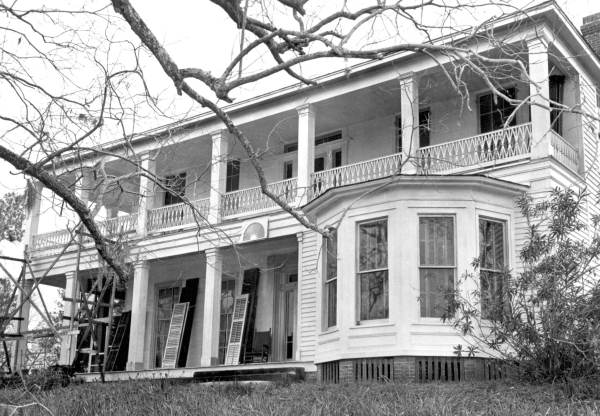
History
Pardon our Dust
Orman House is closed for tours as we conduct a preservation project on the home. The Three Servicemen Detail Plaza and Chapman Botanical Gardens are open for visitors. Restrooms are not available.

Built in 1838 by Thomas Orman, this antebellum home overlooks the Apalachicola River and was used for both business and social gatherings.
Orman was a cotton merchant and business owner in Apalachicola from 1834 to the 1880s. He helped the tiny town become one of the Gulf Coast’s most important cotton exporting ports during the mid-19th century. The house features details of both Federal and Greek revival styles with wooden mantelpieces, molded plaster cornices and wide heart-pine floorboards.
Visit the adjoining Chapman Botanical Gardens, which honors Dr. Alvan Chapman. Enjoy the butterfly garden, other botanical features, walkways and open spaces.
Also plan to visit the Three Soldiers Detail, a bronze replica of the Vietnam memorial statue in Washington, D.C.
Thomas Orman
Down the Apalachicola River flowed the dreams and fortunes of many Floridians. The rivers were the arteries that carried the life blood of a struggling new nation. Entrepreneurs and business owners like Thomas Orman carved our country out of the wilderness.
Friends of Thomas Orman also made their mark in history. Dr. John Gorrie invented the ice machine and was the father of refrigeration. Dr. Alvin Wentworth Chapman became a premier botanist and author of Flora of Southern United States, a taxonomic key describing plants of the southern United States. Visit the Orman House in historic Apalachicola and catch up on 200 years of Apalachicola history.
Orman House, 1890
The finish woodwork, doors, trim and windows for the Orman house were manufactured in Syracuse, New York, sailed to Apalachicola and assembled on-site in 1838.
The two-story Orman House is an outstanding example of Greek Revival style. The original structure contained only four rooms: a parlor and dining room downstairs and two bedrooms upstairs.
Some of the framework is heavy cypress tree trunks held together with large maritime hawsers and wooden pegs. The wooden mantelpieces, molded plaster cornices and wide heart pine floorboards are typical of the time. A rectangular transom with flanking sidelights encased by post and lintels and deeply carved magnolia blossoms at the junctures provides a sense of depth to the doorways. The granite steps off the front porch once graced the entry to a cotton warehouse in Apalachicola, which Orman owned.
William Orman Family
William Orman, son of Thomas Orman, was born in 1830 in Webville, Florida. The Orman family moved to Apalachicola by barge in 1834. He married Annie Virginia Smith in 1866 and had one daughter, Sarah Genevieve (Sadie).
William Orman attended Yale University and studied law. Three years after graduating, he joined the Confederate army and served as a gun boat commander on the steamer Bradford. He patrolled the shoreline off of Fort Pickens, a Union held fort. William marched with the Florida 1st Regiment Company B and fought in the battles of Shiloh and Chickamauga. He was eventually promoted to lieutenant and ordered to stop Sherman's march through Georgia. William served as a brave soldier and gallant officer under generals Bragg, Hood and Johnston in the surrender at Greenville, North Carolina.
After the war, William was a two-term congressman in Florida. He was also active in local Apalachicola politics, was a key player in bringing the railroad to town, and was instrumental in revitalizing Apalachicola after the war.
The Parlor
Thomas Orman was a key factor in the success of early Apalachicola as it grew into the third largest cotton shipping port on the Gulf Coast.
The prominent families of Apalachicola entertained extensively, sparing no expense as they furnished their homes with the very best Europe had to offer. There were European consulates based in Apalachicola, and the prominent families competed for European shipping contracts.
Music would have filled the rooms of the Orman House as guests danced to the melody of Strauss' dreamy waltzes. Dinner was prepared in the summer kitchen behind the house and brought into the dining room, where discussions were held concerning the cultural attitudes of the time and extensive business ideas, including the new idea of manufacturing ice.
In the Orman parlor, Dr. Chapman spoke of botany and Captain Robert E. Lee sought locations for naval bases. European coal brought over as ballast on ships from Liverpool was used to heat the home. Talk of hope for a new state, as well as plans for dealing with pestilence and how to best survive and prosper in the unsettled and undeveloped land that was Florida, would have also occurred at the Orman House.
Judge's Chamber
Sarah (Sadie) Genevieve Orman was married in 1892 to John Fenimore Cooper Griggs, a circuit court judge who was nominated as one of the first captains over Florida's ports, serving as the customs agent for the entire state.
Sadie and Griggs spent most of their time in Tampa and Jacksonville, but, after the death of her grandmother, Sadie and Griggs took possession of the Orman House in 1896. The judge did not want his business dealings to interfere with the running of the house, so he built an office on the front of the house and his room became known as the Judge's Chamber. Griggs added an entry door off the front porch so his clients could come and go without interrupting the household.